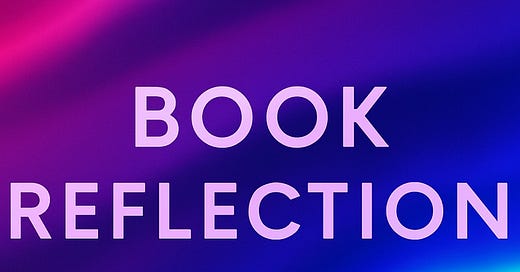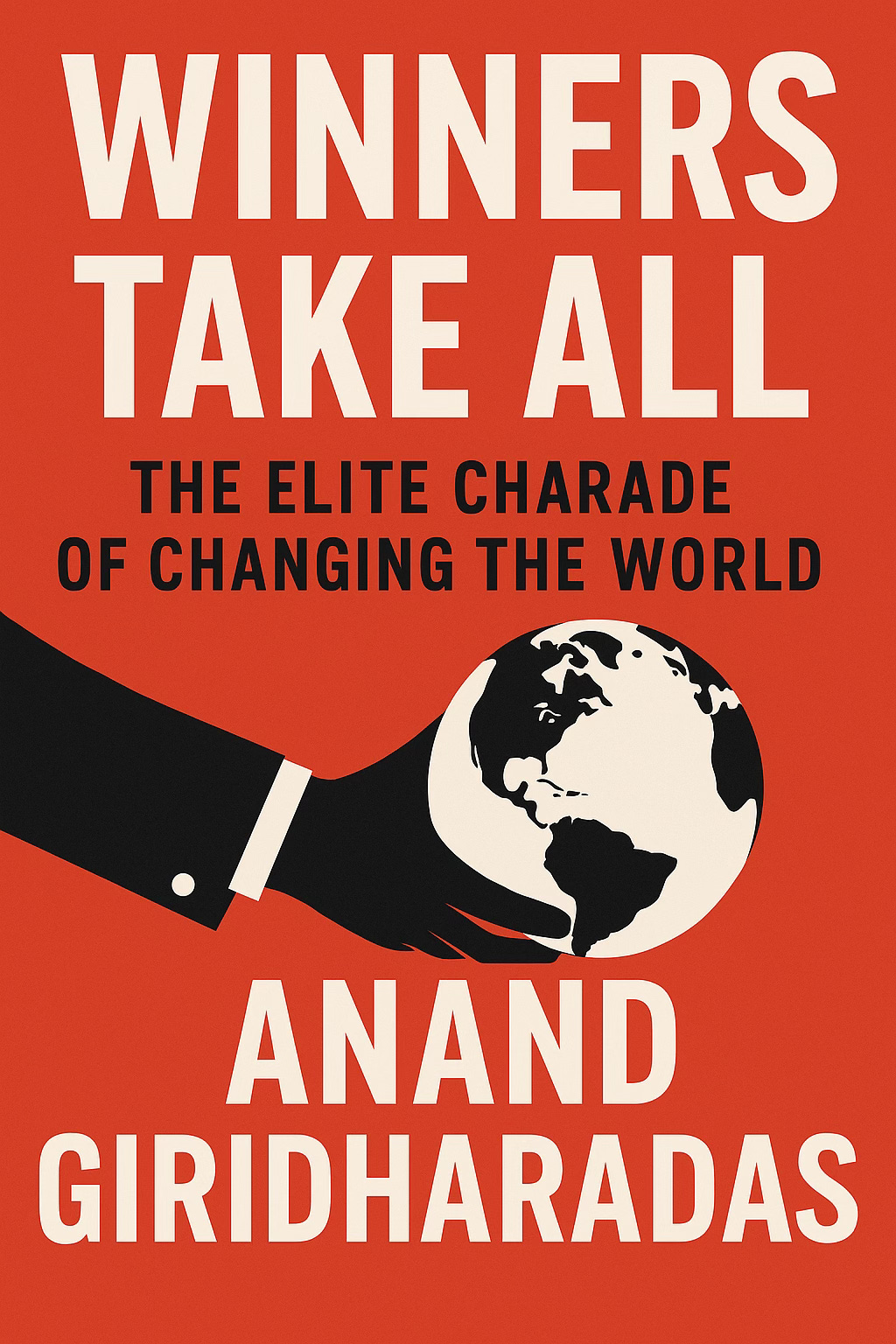Book Reflection: Winners Take All
Reflections on Winners Take All: The Elite Charade of Changing the World
Welcome to another installment of my Book Reflection series — a space where I sit down and reflect on my recent reads. In this series I answer the same questions to offload my thoughts on the book.
Today’s book is Winners Take All: The Elite Charade of Changing the World by Anand Giridharadas. I borrowed the audiobook from my local county library.
Why did I want to read the book?
I picked up Winners Take All because of the ongoing personal inquiry I’ve been in since Trump’s second inauguration on January 20, 2025. That inquiry? Power—specifically the networks of power in the U.S., who holds it, and how they sustain it. Some of the books I’ve read explore this through a historical lens, others focus on the present. But one conclusion is increasingly clear: a distinct class of people is steering the direction of the country. These individuals often share a pedigree—they’re educated at elite institutions, funneled into consulting firms, or deeply embedded in Silicon Valley. This book promised to interrogate the self-image and logic of that class, especially their insistence that they’re doing good even while hoarding wealth and maintaining systems of inequality.
That’s what intrigued me: What story are these people telling themselves? How do they rationalize what they’re doing as moral or noble, even as they cement their influence? I read this book hoping it would help me understand that internal narrative—and challenge it.
What was I hoping to get out of it?
I came to Winners Take All hoping to understand more about the individuals who dominate elite circles in the U.S.—not just by wealth, but by influence, ideology, and network. What are they taught in school? How do they compartmentalize their private ethics from their public impact? The title alone is damning—there’s clearly something amiss in how these individuals go about shaping the world. So naturally, I wanted to know: what are their methods? How do they rise? Where do they live? What were their childhoods like? What hopes or expectations were pressed upon them by their parents, and when exactly did their thinking go astray?
And ultimately, I was hunting for the central flaw in their worldview. What is the false promise at the heart of their logic? How did it get so distorted—and why did so many of them cling to it even when it became clear the results weren’t just ineffective, but harmful?
What stood out to me most while reading?
What stood out to me most was the final chapter and epilogue—they were, without question, the most revealing and damning parts of the book. And, to be honest, they caught me off guard.
To give a bit of context: we’re living in a time that feels more surreal by the day. On Donald Trump’s 79th birthday, over five million “No Kings” protestors gathered across the U.S., while at the same time, Trump held a military parade to celebrate the Army’s 250th anniversary. Against that backdrop, I’ve often wondered aloud (including to my husband): where is the leadership coming from on the Democratic side (or honestly just in America)? Jokingly, I’ve suggested that Clinton, Bush, and Obama should start a podcast together—something that might bring real, nuanced political leadership back into the public conversation without interfering in the more radical realignments currently underway. They can’t run for president again, so they are by definition, non-threatening.
So it was jarring—truly jarring—to read Anand’s takedown of the Clinton Foundation in the final chapter. The foundation was positioned as a prime example of elite “win-win” thinking: the idea that social progress should be privatized and run through the same people and structures that created the inequality in the first place. At one point, the author weaves in a 1996 quote from Bill Clinton declaring that “the era of Big Government is over.” That moment, under the light of everything the author described, felt like a complete betrayal of the very institution that had made his rise and influence possible.
I don’t blame Bill Clinton alone—but this was a sharp illustration of just how deep the delusion runs among the elite class. These are people who view government not as a public good, but as something inefficient or outdated—best replaced by corporate benevolence. It’s a logic that sounds generous on its surface but functions to uphold the very systems that benefit them most.
The epilogue brought this critique to a head. Anand introduces someone who doesn’t mince words and doesn’t let the elite off the hook, Chiara Cordelli. She directly confronts the elites, saying plainly that you can’t be a “good company” if you’re funding lobbyists who fight corporate tax increases—even if you also happen to donate to social causes on the side. The kid gloves were off. It was a full-circle moment that nailed the moral contradiction at the heart of so much elite “giving.”
What did I realize or think about differently?
I realized that for the elite class Anand critiques, there is no cognitive dissonance. They’ve been immersed in a world of constant affirmation—from business school teachings, bestselling books, peers, and thought leaders—all reinforcing the same foundational belief: the “win-win” mindset. The idea that it is a moral imperative for those with wealth to give back through philanthropy isn’t questioned. It’s celebrated. On the surface, that sentiment seems fair: if you have more, you should give some away. But the insidious part is that this charitable impulse often comes without any public reckoning or acknowledgment of how that wealth was accumulated. Or perhaps more importantly, what systems it may have harmed or prohibited from progressing along the way.
The picture painted by the author is striking: this group of people is so deep inside their own ecosystem of influence that they don’t even realize their complicity. Their solutions are curated in echo chambers. They are insulated from consequences. And worse, they’re applauded for playing savior without being held accountable as contributor. Because it is true, they are the only ones attempting to redistribute their wealth.
And here’s the uncomfortable part: I can see where I’ve taken cues from these same tactics. Where I’ve absorbed wisdom from the same structures, frameworks, and personalities that perpetuate the problem. It pisses me off. It pisses me off to think that this ideal is something that I chased after. Of course I never succeeded in it, perhaps because I myself can’t be fooled by the illusion. Nonetheless, I’ve sipped the Kool-aid.
Ironically, I don’t think these people are evil or malicious. I think they’ve been handed tools to rationalize their strange place in the world—tools that help them cope, but that also ensure they never question the very position they’re coping with. Maybe the simplest way to explain it is this: if you’re one of the elite, go to Walmart. Actually walk the aisles. See how the rest of America buys their groceries. It’s not the worst place—but it is real. It offers low-cost goods, some variety, and most importantly, interaction with fellow citizens. Which is wildly different from the Amazon model: convenience without community, choices without context, a life reduced to a photo of a box dropped at your door. And that I think sums up their approach, create more bubbles and private places for people to exist. Places where you don’t ever have to go outside and see reality for what it is.
Maybe summarized in one sentence: they’re building tools and systems to create an escapist reality deisgned to separate themselves from the everyday of American existence.
Was there anything that didn’t work for me?
Some of the early chapters, particularly the initial stories and character portraits, didn’t quite land for me. While I can appreciate that they were laying the groundwork to expose how deeply embedded and normalized this worldview is, the shifts in those characters didn’t resonate with the same weight or clarity as the arguments later in the book. In retrospect, I understand why those narratives were included—they help illustrate how thoroughly these ideas take hold and evolve—but it felt like we could’ve cut to the chase sooner. Much like the epilogue, I found myself wishing for more directness, more honesty, earlier on.
Did this book connect with anything else I’ve read, seen, or experienced?
Absolutely—it gave me a new lens through which to understand the internal conflict within the Democratic Party. It added clarity to the question I’ve long wrestled with: Why are so many well-meaning, wealthy people still complicit in maintaining the status quo? The book lays out that it isn’t necessarily malice, but rather a delusional reinforcement loop—built on elite education, business norms, and philanthropic ego—that insulates them from recognizing their true impact.
More than anything, it gave me a useful way to distinguish between those who are earnestly committed to democracy and those who prefer to operate from the safety of their virtual castles. That single point—do they trust and invest in democratic institutions, or do they just want to solve things their way, from afar?—has already helped me clarify my thinking about some prominent figures and their choices.
Would I recommend it?
Yes, I’d recommend this book—especially the final chapter and epilogue—if you’re trying to make sense of the strange, distorted version of America we’re living in right now. It’s particularly useful for anyone who wants to understand how so many well-educated, well-meaning, and ostensibly “good” people have ended up so out of touch with the lived reality of most Americans.
If you’ve ever struggled to articulate why something feels off about billionaire philanthropists or tech leaders claiming to “give back,” this book will give you the language and framing to explain that dissonance. It’s not about villainizing individuals—it’s about exposing how an entire class of people have come to believe their wealth and power should be preserved and celebrated under the guise of social improvement.
If you’re looking for a way to define the void between elite narratives and everyday American life, this book—especially its closing moments—offers a reason.
Final Reflection
This book gave me a lot to chew on. Not just about how the elite think—but about how power is rationalized, redirected, and reframed to maintain the illusion of benevolence. What it unlocked most, though, was a way to talk about all of this. A way to approach those in political leadership, to parse out what feels so off, and to finally articulate what I’ve been circling around: we don’t have to burn it all down, and the system can’t stay the way it is. There is, as Bill Clinton once said, a third way. But unlike the way Clinton meant it—this third way needs to come from the people.
We can build something new. We can build it alongside the old structures—not in opposition to them, but as a pressure point. A modern system that requires people to opt in, to lend their voice and their values, not just to vote once every four years but to actively shape what governance looks like. This is how we cultivate democracy—not by handing it over to billionaire technocrats who fund glossy versions of “doing good,” but by reclaiming the messy, iterative, collective power of self-governance.
The most important takeaway for me: only government—truly accountable, publicly shaped government—can take on reform that is sincere. True change can’t be subcontracted to philanthropists with pet projects or consultants with a “win-win” spreadsheet. If we want to rediscover the American dream, it has to be our dream again—not theirs.
And if we’ve stagnated, maybe it’s because we’ve become too afraid. Afraid of criticism, of being wrong, of trying something new in the open air of public life. But we were never meant to do this alone. What this book makes clear is something I’ve always believed: we are better together. And that’s still worth building for.





